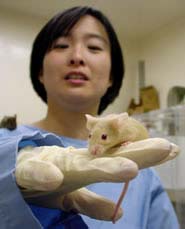DREAM raises pain relief hopes

No dream: these mice feel little pain. <br>J. Penniger <br>
Missing protein leaves mice impervious to pain
Researchers have a new lead for treating pain. A protein called DREAM appears to play a key role in how mice respond to heat, touch and inflammation1.
Mice lacking DREAM seem oblivious to all types of pain, find Josef Penninger and his colleagues at The AMGEN Institute, Toronto, Canada. The animals can bear acute pain – the kind caused for example by heat, pressure, or injections as well as chronic inflammatory pain – that which arthritis patients suffer. They seem otherwise normal.
DREAM was first identified in 1999, when it was known by three different names and had three different proposed functions in biological systems. “It was very unpredictable what DREAM would be doing physiologically,” says Penninger.
The protein’s full name is Downstream Regulatory Element Antagonistic Modulator. Low DREAM levels are accompanied by high levels of dynorphin in the mice’s spinal cords. This morphine-like substance is believed to alleviate the animals experience of pain. “It’s exciting because it looks to be so specific,” says Penninger.
While the results suggest altering DREAM function might be a way to change pain perception, practical applications are a long way off. “This is a major mechanistic insight,” says John Wood who studies pain receptors at University College in London – but whether or not DREAM acts in a similar way in humans remains to be seen, he cautions.
Current estimates suggest that one in five people worldwide live with chronic pain from cancer and other debilitating diseases. Treatments with fewer side effects than existing analgesics have long been a goal for researchers.
References
- Cheng, H.-Y. M. et al. DREAM is a critical transcriptional repressor for pain modulation. Cell, 108, 31 – 43, (2002).
Media Contact
More Information:
http://www.nature.com/nsu/020114/020114-1.htmlAll latest news from the category: Health and Medicine
This subject area encompasses research and studies in the field of human medicine.
Among the wide-ranging list of topics covered here are anesthesiology, anatomy, surgery, human genetics, hygiene and environmental medicine, internal medicine, neurology, pharmacology, physiology, urology and dental medicine.
Newest articles

Why getting in touch with our ‘gerbil brain’ could help machines listen better
Macquarie University researchers have debunked a 75-year-old theory about how humans determine where sounds are coming from, and it could unlock the secret to creating a next generation of more…

Attosecond core-level spectroscopy reveals real-time molecular dynamics
Chemical reactions are complex mechanisms. Many different dynamical processes are involved, affecting both the electrons and the nucleus of the present atoms. Very often the strongly coupled electron and nuclear…

Free-forming organelles help plants adapt to climate change
Scientists uncover how plants “see” shades of light, temperature. Plants’ ability to sense light and temperature, and their ability to adapt to climate change, hinges on free-forming structures in their…





















